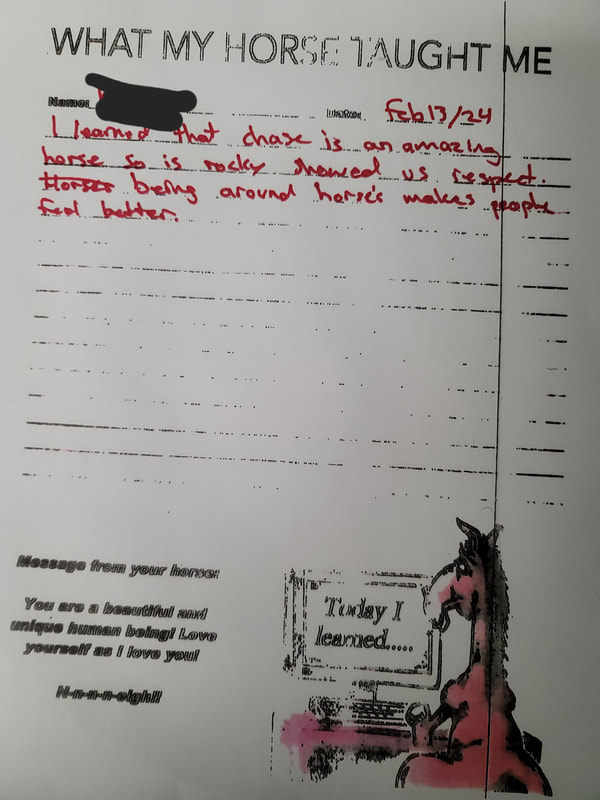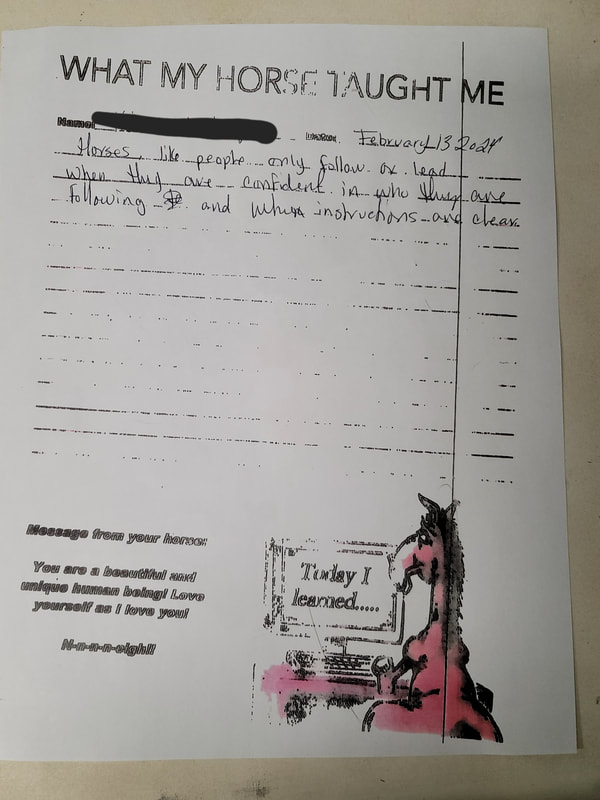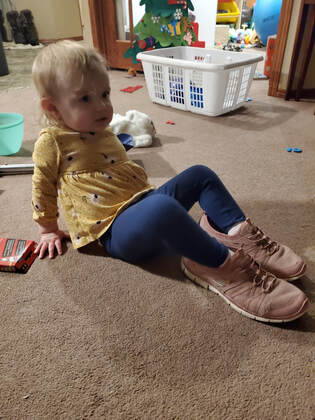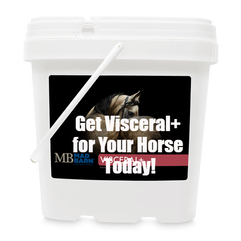|
Chronicles of a Stable Owner are real-life stories about caring for horses and their people
Written by Dr. Gwen Donohoe, Owner/Manager at Sagehill Stables Research conducted by Dr. Ann Baldwin at the University of Arizona has confirmed what equestrians have always known and felt - that horses seem to have a way to connect with your soul. In fact, that feeling is your heart rate frequency synchronizing with your horse! Dr. Baldwin's research program focuses on finding ways that humans can resist stress and she has combined this research with her own experience and passion for horses. Her team discovered that as humans interacted with horses, horse and human heart rate variability became coherent in the majority of participants studied, meaning their heart rate frequencies matched that of the horse they were working with. Normally, human and horse heart rates have different levels of frequency. They found that this coherence between horse and human heart rate frequency happened with the human heart rate following that of the horse heart rate over time, suggesting that the human heart rate was trying to match or follow the horse heart rate frequency. These matching frequencies in heart rate were shown to be strongest when humans were told to express positive feelings to the horse, but were also found when participants were just sitting quietly in the horse's presence. One possible explanation for these matching frequencies was proposed to be that horses have a larger electromagnetic field than humans and that this can influence human heart rate frequency. So what does this mean? This is part of the phenomenon we talk about when we spend time with horses; that individuals are able to focus on the present and live in the moment. When our...
0 Comments
Horse Health Tips For Students includes information for our students about common horse health care issues. These posts are to bring awareness to horse welfare issues - always ask your veterinarian for advice and treatment protocols for your own horse!
This year we decided to make our own home-made fly spray! Typically in the summer we go through 1.5 to 2, 4-L jugs of fly spray each week. At a cost of $60 to $90 per jug, we decided that this was the year we needed to do something different. So we researched a few different recipes and made our own from a combination of a few recipes we found. We were surprised to learn that in-fact apple cider vinegar should not be used for fly spray as it attracts flies! Here is our recipe: Ingredients: - 2 litres of vinegar - 1 litre of Pinesol (regular scent) - 2 tablespoons dishsoap - 25 to 30 drops of eucalyptus essential oil (or can substitute for lemon scented essential oil) - approx. 1 litre of water Directions: In an empty 4-L jug, mix the first 4 ingredients. Add water to fill the rest of the jug. Put into a fly spray bottle or wipe on horses with a rag. Avoid getting spray in or around their eyes. So how did it work? I think it actually worked quite well at repelling flies for the horses for the short-term anyway. To be honest, I couldn't tell much difference between using our home-made version and store bought fly spray. It worked well enough for farriers, vets and students to get relief from flies on the horses while working with them and riding. How long it lasted out in the field I couldn't say, but I didn't feel the horses were overly bothered by flies this summer. Maybe the most important part is that is cost less than $10/week to supply fly spray for 25 horses. We will definitely use it again next year. Chronicles of a Stable Owner are real-life stories about caring for horses and their people
Written by Dr. Gwen Donohoe, Owner/Manager at Sagehill Stables What is it about horse girls? If you've ever met one, you know that they seem really obsessed with being at the barn! In fact, I get told by parents on almost a weekly basis that their daughter would like to just live at the barn if she could! They don't have to be riding, they just want to be there. They clean up poop, they walk for hours leading others for pony rides, they help others catch and clean their horse, they feed horses, they do whatever is needed, and all with a smile on their face. In fact, there are many adults at the barn that are still like this, helping clean-up and secretly filling our first-aid and horse care supplies or bathroom toiletries when I'm not looking. Parents that come and want to sweep or help muck stalls while their kids ride. It is an environment where everyone can see that there is always work to be done and they want to be part of it. They want to help the horses and the staff and they want to be part of the barn community. And that's what it is, a barn community. It's something that just happens when you get a group of people with the same passion together. And it's now been included as a part of the reason why horses and being around horses can have such a therapeutic effect on people. Chronicles of a Stable Owner are real-life stories about caring for horses and their people
Written by Dr. Gwen Donohoe, Owner/Manager at Sagehill Stables This story is about a pony named Dixie, one of our leased lesson horses that we take care of here at Sagehill Stables. First I want to give some background on ponies before we start the story. Ponies in general often have a bad reputation in the equestrian world for being naughty, and there is some truth to it. There are a few different reasons this might be. First, they are smaller than most horses and often live together with horses that are much bigger than them. This must cause some issues in the social pecking order, as much of their pecking order is based on dominance and the ability to protect the herd. As a pony, they would constantly have to be challenged for their place in the pecking order and as a smaller horse likely have to try twice as hard to make it up the ladder against horses that are bigger and stronger than them. In our experience, when ponies are in pens together, they often buddy up and it can be seen that they are obviously friends, so size does matter. Secondly, ponies... Chronicles of a Stable Owner are real-life stories about caring for horses and their people
Written by Dr. Gwen Donohoe, Owner/Manager at Sagehill Stables It seems to be a common theme in the equestrian industry (and other animal businesses too for that matter) that volunteering and volunteer programs are pretty common, and expected even. And there is good reason for it. There is only so much time in a weekly lesson, and to get good at something or master something, you really need daily practice. Taking lessons more than once a week is often cost-prohibitive for many families, so what options are there for students to get that extra experience? The answer is volunteering. Unless you have horses in your back-yard, volunteering is an essential part of the development of confident and capable equestrians. Unlike other sports, you can't really practice in your backyard, or even at your neighbourhood playground or park. For those that have their own horse at home, youth still have a hard time getting lots of quality, safe supervised hours in if mom and dad are busy. Spending those extra hours at the barn are just as important as taking the lessons themselves. This past week we've been featuring our coaches on social media! A common theme throughout the coach profiles is that most of them started by volunteering and doing barn chores... the physical benefits of horseback riding for Youth: get your butt back in the saddle girl1/24/2023 Chronicles of a Stable Owner are real-life stories about caring for horses and their people
Written by Dr. Gwen Donohoe, Owner/Manager at Sagehill Stables Although many may think that owning a barn must mean I ride horses whenever I want, often the exact opposite is true. In fact, since starting a horse business, I have never ridden less. There are lots of excuses. The main one being "there is always too much too do", followed closely by, "I'm too tired after spending a day working at the barn, the last thing I want to do is spend more time at the barn." However, now that I have a daughter, I am trying to make myself get out to the barn a couple times a week with her so that she can experience all the amazing benefits of horses that I experienced as a young girl. Even at only 21 months old, after a couple of 2 to 3 minute rides with Zip last week (that's about all the attention span she has right now!), I could already see a huge a difference in her core activation and wanting to talk more. Amazing! Now, you could say this is just a coincidence and that at her age these are normal development stages. But I don't believe in coincidences, I'm all about science. So, I've refreshed and updated my list of research on the benefits of horse back riding to youth. The last few years I have really been focused on the research behind the mental health benefits of horses to people, that I forgot about the whole host of physical benefits they provide too, which are just as important to all of us. I haven't found any research dealing with children under 2 yet, but I did find some great research regarding youth, including youth with Autism and ADHD. My favourite is the case study written by Dr. Temple Grandin about her own experiences as a child with Autism. Although her research and fame is more well known in the cattle industry for bringing in humane handling practices in feedlots and processing facilities, her experiences and observations all started with horses as a youth. She talks about the benefits that horses provided her which came not just from riding, but also from the barn atmosphere, chores and friendships made there as well. There is even a movie staring Claire Danes all about her life (available on Crave TV I believe). Another study that had similar findings as Dr. Grandin is discussed in an article by Jasmine Root (2018). She talks about Dr. Ann Swinker's research that found that handling, riding, and caring for a horse or pony can develop a host of positive traits in a child, including responsibility, accountability, patience, level-headedness, empathy, kindness, and self-discipline. Another study by N. Ohtani et al. (2017) talks about what it is about horseback riding that helps stimulate our brains and bodies - it's the horse's vibrations that you experience when riding. These vibrations were found to improve children's self-control and ability to make good decisions. In a study by V. Chandler (2022) horseback riding appeared to have improved balance, posture, and core strength in children with ADHD and ASD, and anecdotal evidence from parents suggested many positive behavioral benefits as well. If you think about the amazing benefits that horses have for kids with physical challenges like ADHD and Autism, you know that horses can benefit any child or person in the same way. And now just think of the benefits I could be providing myself if I could get my own butt back in the saddle... Follow the link below to read these articles on the physical benefits of horses to children and youth. Chronicles of a Stable Owner are real-life stories about caring for horses and their people
Written by Dr. Gwen Donohoe, Owner/Manager at Sagehill Stables Night check nights have me awake until well after midnight. It is my least favourite thing to do - drag myself to the barn at 9:30 or 10pm and do physically demanding work when all I want to do is relax after an already physically demanding work day on top of dealing with client relations. At least I don't do it every night anymore. However, it never fails that after I finish night check, I feel energized and can typically get in another 2 to 3 hours of work (or 2 to 3 hours of Netflix binging...). And here I find myself for the first time in several months being able to bring myself write something. January is nearly finished and I can feel the days are already starting to get longer. Time is moving slower compared to the fall, which seems to have whizzed by in a blur of exhaustion. Although the days of Covid shut-downs and regulations seem to be mostly behind us, covering for sick staff and the admin of dealing with constant cancellations and re-booking for sick clients and staff took a serious toll both mentally and financially. It seems like maybe others were also feeling the strain of the hectic fall too, and just like that, we were suddenly in the lowest registration winter session we've had since pre-Covid. Chronicles of a Stable Owner are real-life stories about caring for horses and their people
Written by Dr. Gwen Donohoe, Owner/Manager at Sagehill Stables This past weekend, our rescue pony Rocky, who has now been with us for 8 years, finally did his first birthday party! Thanks to a skilled and determined staff member who made the effort to lead him, he did great. Not only was it heart warming to see, but a huge relief. I probably should have, and could have, sold or given away this pony many times, but I just couldn't seem to bring myself to give up on him... It made me reflect on how hard horse ownership can really be... For most horse-struck girls, owning their own horse is a life goal. The idea of having a horse of their own to ride and care for, and have a special bond with, seems like a fairy tale. And for parents who have seen the amazing positive life changes horses and riding lessons have brought to their daughters lives so far, they are obliged to aid in their daughters dream and take the next step to own a horse. After doing research on the costs of owning a horse, and finding a qualified coach to aid in the purchase, I've seen many parents go ahead and make the plunge into ownership. And time and time again I've also seen the challenges that arise, that no amount of research can prepare the parents and horse-loving daughter for. Horse Health Tips For Students includes information for our students about common horse health care issues. These posts are to bring awareness to horse welfare issues - always ask your veterinarian for advice and treatment protocols for your own horse!
Overheating horses can be a problem particularly in the summer on hot, humid, buggy days. However, horses can overheat all year round, even in our cold climates. It's important for students to recognize the signs and know what to do to help prevent overheating. Signs of Overheating - excessive sweating - skin hot to touch and above normal body temperature - signs of dehydration (i.e., poor skin elasticity, sunken eyes) - lethargic, muscle weakness, stumbling, lack of coordination - above normal breathing and pulse rates that don't recover after exercise Chronicles of a Stable Owner are real-life stories about caring for horses and their people
Written by Dr. Gwen Donohoe, Owner/Manager at Sagehill Stables It had been a beautiful 10 days of no rain and hot weather, and I finished baling all the hay. The tractors air conditioner quit working the last two days of baling, so it was like driving around in my own personal Thermea spa; hotter inside the cab than outside! I tried to keep reminding myself that people pay a lot of money for this experience... The air conditioner break-down was nothing compared to the last month's series of unfortunate events however... It started about a month ago... I started up the tractor to feed some hay, but something sounded not quite right. I turned around to park the tractor, but as I did the noise got extremely loud! I turned off the tractor. Smoke started coming out from the engine! I grabbed the fire extinguisher but there was no fire... The tractor was dead right in the middle of the parking lot... |
AuthorGwendolyn Donohoe, PhD, is the owner/manager at Sagehill Stables. Read more here Archives
March 2024
Categories
All
|







